Geoscience Reference
In-Depth Information
-20
AD
1711
-25
Roman Empire
LIA
Younger Dryas
MCA
-30
-35
Bronze Age Crisis
Dark Ages
4.2 kiloyear event
'8.2 kiloyear event'
-40
Holocene
-45
Allerød and Bølling
-50
0
2
4
6
8
10
12
14
16
Age (kya)
Fig. 5.3
CentralGreenlandtemperaturefromthebeginningofthe18thcentury(endofthepre-industrialera)to
16000yearsago.AsearlycivilisationswerebasedinthenorthernhemisphereandastheGreenlandicecore
providesanapproximateproxyforprincipalchangesinthathemisphere'sclimate,sothisrecordcontains
elementsofhemisphericclimatechangethatafectedearlycivilisations.
Note:
regionalvariationwithinthe
hemispheretakesplaceascirculationpatternschangewithglobaltemperature.Solookforchangeinthis
temperature(irrespectiveofdirection)asamarkerofsocietalimpact.AlsonotethatcentralGreenland
temperatureisnotthesameasglobaltemperature.Year0onthe
x
axisis1950.DatafromAlley,2004,and
obtainedfromGISP2IceCoreTemperatureandAccumulationData.IGBPPAGES/WorldDataCenterfor
PaleoclimatologyDataContributionSeries#2004-013,downloadedfromftp://ftp.ncdc.noaa.gov.Theoriginal
journalpublicationwasAlley(2000).LIA,LittleIceAge;MCA,medievalclimaticanomaly.
Holocene's commencement and continued through to about 7000 years ago. Con-
sequently some of the early coastal civilisations became inundated, as is evident
from the submarine remains of settlements in the Mediterranean and off the coast
of India. This was probably the earliest major impact of global climate change on
human civilisation. That is to say, an impact as a direct result of climate on the most
advanced type of human activity at the time (unless one were to argue that, prior
to settlements of buildings, the development of the use of fire during some of the
preceding Quaternary glacials/interglacials amounted to civilisation).
Getting an idea of the principal times of Holocene climate change in various parts
of the world is difficult. However, an indication of the timings of principal change in
the northern hemisphere can be gleaned from Greenland ice cores (see Figure 5.3).
These times of climate change saw changes in the pattern of atmospheric circulation,
and hence the distribution of precipitation and seasonal patterns.
Even without a complex civilisation, just small settlements, humans have been
subject to the vagaries of climate change from the beginning of the Holocene (and
presumably earlier in prehistory). The greening and ultimate desiccation of the Sahara
is probably among the single most severe climatic fluctuations of the Holocene (but
not the single most severe abrupt event). Ecosystem succession in the Sahara is
well known from many lines of evidence such as pollen spectra, palaeolake levels





























Search WWH ::

Custom Search